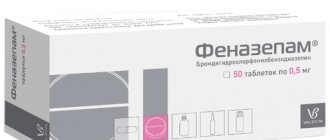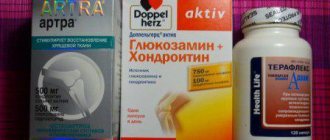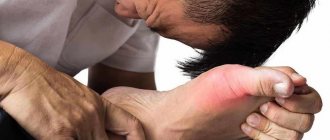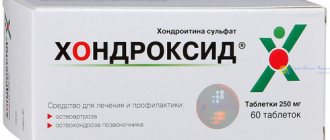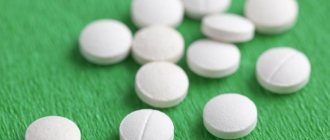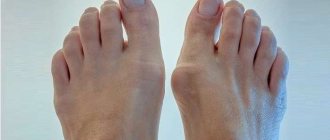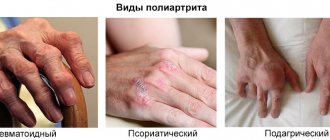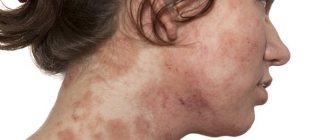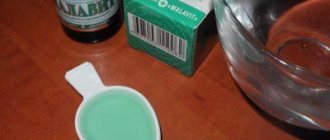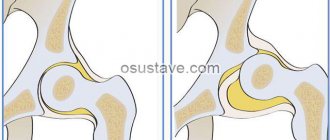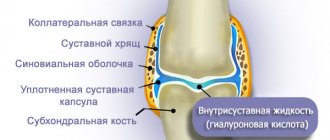What is chondroitin
This substance is a component produced by the cartilage tissue of human joints. Chondroitin sulfate is a component of synovial fluid. This substance plays an important role in the functioning of the body’s skeletal system:
- regulates metabolic processes in cartilage cells;
- promotes the synthesis of hyaluronic acid;
- participates in the process of calcium deposition in bones.
Chondroitin is a chondroprotector, helps strengthen ligaments and tendons, and has a strong analgesic and anti-inflammatory effect. This substance:
- provides shock absorption when moving;
- promotes bone tissue regeneration;
- increases functional mobility of the joint capsule;
- inhibits the process of degeneration;
- improves the properties of synovial fluid;
- Helps restore the cartilage surface of joints.
What do they get it from?
The drug Chondroitin sulfate is made from bone marrow, tendons, skin, and cartilage. The working material is animals and fish. Depending on the base, the substance differs in purity, characteristics, bioactivity, and formulas. Low molecular weight fractions are obtained from salmon fish. The composition isolated from animals has less biological activity. Cartilage is used to make the drug:
- cattle;
- pigs;
- spiny sharks - katrans;
- sturgeon fish;
- stingrays;
- salmon;
- salmon
What are glucosamine and chondroitin for?
Small amounts of these two substances, necessary for normal joint function, are produced by the body. Partially they come from food - they are present in beef, hard cheeses, and poultry. Substances included in dietary supplements. Glucosamine sulfate in the body is intended to produce hyaluronic acid, building the chondroitin molecule. This substance helps:
- synthesis of articular cartilage;
- strengthening metabolic processes;
- increasing joint mobility;
- improving cartilage nutrition;
- pain relief;
- slowing down the leaching of calcium from bones.
The difference between chondroitin is its ability to suppress enzymes formed during diseases and injuries. These substances contribute to the destruction of cartilage. Uses of Chondroitin sulfate:
- activates the formation of synovial fluid;
- inhibits the destruction of bone cartilage cells;
- reduces pain when moving;
- relieves inflammation of joint capsules;
- increases the mobility of affected joints;
- improves calcium-phosphorus metabolism in connective tissues;
- stimulates the synthesis of hyaluronic acid.
Pharmacological properties
Many people are interested in how quickly Chondroitin injections work.
The substance chondroitin sulfate is the main component of proteoglycans, which in combination with collagen fibers form the cartilage matrix. It has effective chondroprotective properties, inhibits the activity of enzymes that provoke the degradation of articular cartilage, improves metabolic processes in cartilage and subchondral bones, stimulates the production of proteoglycans by chondrocytes, affects the level of phosphorus-calcium metabolism in cartilage tissues, stimulating their restoration, and participates in the construction of basic substances cartilage and bone tissue.
“Chondroitin” in injections has an anti-inflammatory and analgesic effect, helping to reduce the release of inflammatory mediators and pain factors into the synovial fluid through synoviocytes and macrophages of the synovial membranes, inhibiting the production of prostaglandin E2 and leukotriene B4. Chondroitin sulfate prevents the collapse of connective tissues, stimulates the regeneration of cartilaginous articular surfaces, normalizes the production of joint fluid, thereby improving joint mobility, reducing the intensity of pain and accompanying inflammation, and also reducing the need for the use of anti-inflammatory non-steroidal drugs. For degenerative disorders in cartilage tissue, this drug is a replacement therapy drug.
Injections with chondroitin for joints work relatively quickly - the effect is felt after about 2-3 weeks, when the clinical signs of reactive synovitis disappear and the range of movements increases. At the end of treatment, the effect lasts up to 6 months.
Composition of the drug and release form
The active ingredient of all drugs is chondroitin sulfate, but each time it has its own dosage. Auxiliary components depend on the release form. Chondroitin sulfate is produced:
- for oral administration – capsules, tablets, powder (sachet);
- for external use – ointment, gel;
- for injections - lyophilisate powder, solution for injection.
The composition of the drug depends on the form of release:
- Chondroitin lyophilisate in ampoules. Contains Chondroitin sulfate 100 mg.
- Tablets and capsules. Active substance – 250 mg. Auxiliary components in tablets are calcium stearate, lactose. The capsules contain propylparaben, sodium lauryl sulfate, methylparaben, titanium dioxide, gelatin, water.
- Ointment and gel. Active ingredient – 5 g, auxiliary ingredients – macrogol glyceryl hydroxystearate, neroli oil, orange, lavender, trolamine, carbomer, nipagin, disodium edetate, dimexide, propylene glycol, purified water.
- Artra MSM Forte - instructions for use in tablets, indications, composition, side effects, analogues and price
- New generation chondroprotectors
- How to use hyaluronic acid for youthful skin
Notes
- ↑ 1 2 3 4 5 6 7 8
Gichev Yu. Yu., Gichev Yu. P.
Guide to micronutrientology.
The role and significance of biologically active food additives . - M.: "Triad-X", 2006. - 264 p. — P. 151 - Search in the drug database, search options: INN - Chondroitin sulfate
, flags
“Search in the register of registered drugs”
,
“Search TKFS”
.
Circulation of medicines
. Federal State Institution “Scientific Center for Expertise of Medical Products” of Roszdravnadzor of the Russian Federation (08/23/2010). Archived from the original on August 22, 2011. Retrieved January 3, 2012. - Mucopolysaccharides (Chondroitin Sulfates) As Dietary Supplements: Sources, Production and Comparative Bioavailability
- https://www.fasebj.org/cgi/reprint/20/7/803.pdf (English)
- Stephen Barrett, MD
Glucosamine and Chondroitin for Arthritis: Benefit is Unlikely. Quackwatch (06/22/2010). Archived from the original on April 6, 2012. Retrieved April 25, 2011. - Elena Malysheva
“Health” program dated March 31, 2007 (Russian) (from 15 minutes). Archived from the original on April 6, 2012. - Simon Wandel, Peter Jüni, Britta Tendal, Eveline Nüesch
Effects of glucosamine, chondroitin, or placebo in patients with osteoarthritis of hip or knee: network meta-analysis. BMJ Publishing Group Ltd. (5.07.2010). Archived from the original on April 6, 2012. Retrieved April 25, 2011. - Clegg DO, Reda DJ, Harris CL, et al. (February 2006). "Glucosamine, chondroitin sulfate, and the two in combination for painful knee osteoarthritis." N.Engl. J. Med. 354 (8): 795–808. doi:10.1056/NEJMoa052771. PMID 16495392.
- Rozendaal RM, Koes BW, van Osch GJ, et al. (February 2008). "Effect of glucosamine sulfate on hip osteoarthritis: a randomized trial." Ann. Intern. Med. 148 (4): 268-77. PMID 18283204.
Indications for use
The drug Chondroitin sulfate is prescribed by doctors to treat diseases of the osteoarticular system. The medicine has a healing effect for injuries, inflammatory processes, and is used during the recovery period after fractures. The result is influenced by the form of application and diagnosis. Clinical studies have proven the effectiveness of the drug in numerous joint pathologies.
It is recommended to use the medicine to treat:
- Osteoarthrosis of the spine and joints. The drug stimulates tissue repair, increases the production of hyaluronic acid, and eliminates cartilage replacement surgery. Capsules and injections are recommended.
- Degenerative-dystrophic diseases of the joints and spine. The medicine stops the destruction of bone cartilage tissue, reduces calcium loss, and restores cells. Directions for use: Chondroitin injections.
- Osteochondrosis is only at the initial stage. Ointments and tablets stop inflammation and reduce pain.
X-ray indicators confirmed the effectiveness of the use of Chondroitin sulfate in the treatment of:
- Bone fractures – callus formation is activated during healing, nutrition is improved, and cartilage growth is accelerated. The patient is prescribed capsules and injections.
- Periodontopathies in dentistry - the processes of phosphorus and calcium metabolism are normalized, bone tissue is restored. The product has anti-inflammatory properties, is used in the form of a gel, the course of treatment is 3 months.
When is it prescribed?
Indications for the use of this medication are as follows:
- various stages of osteochondrosis;
- spinal column fracture;
- spondylosis at the initial stage;
- osteoarthritis of the spinal column and peripheral joints;
- periodontopathy.
In the complex treatment of arthritis, chondroitin injections can be used as an adjuvant. Doctors should consider the possibility of increased effects of fibrinolytics, antiplatelet agents and indirect anticoagulants when combined with chondroitin. Therefore, when treating a patient, frequent monitoring of blood plasma coagulation parameters will be required.
How does sodium chondroitin sulfate act on cartilage tissue?
Improving joint function is an important result of using the drug. This is facilitated by the effect of the active substance on cartilage tissue. Chondroitin sulfate:
- normalizes the production of hyaluronic acid, which strengthens the connective structures of cartilage;
- inhibits degeneration processes;
- inhibits the action of lysosomal enzymes that destroy connective tissue, increases its strength;
- promotes cartilage restoration;
- preserves intra-articular fluid;
- improves metabolic processes of cartilage tissue;
- increases the production of synovial fluid.
Mechanism of action
Chondroitin sulfate, entering the body, reaches its maximum concentration after 3 hours. The substance is redistributed through the bloodstream to bone and cartilage tissues. Phosphorus-calcium metabolism is activated. This starts:
- acceleration of recovery processes in bones and spine;
- reduction of painful symptoms;
- increased production of joint fluid;
- increased mobility;
- inhibition of joint destruction;
- acceleration of healing of broken bones;
- pain relief, inflammation relief;
- stopping the degeneration of the joint capsule.
What glucosamine and chondroitin supplements should I take?
Research is mixed. My opinion is that until the effectiveness of these substances has been proven or disproved, it is worth using them periodically, just in case.
Yes, it may be useless (especially when degenerative processes in cartilage tissue have already begun), but how do we know this? What if it helps?
- Taking glucosamine sulfate: daily dosage of 1500 mg (2 times a day, 750 mg or 3 times a day, 500 mg after meals or with meals). Course: 1 month. Course frequency: 2-3 times a year.
- Taking chondroitin sulfate: daily dosage 800-1200 mg (2 doses, immediately after meals). If the drug is weakly concentrated, then the dosage should be increased. Course: 1 month. Course frequency: 2 times a year.
- OINTMENTS AND CREAMS ARE USELESS! They penetrate the skin too poorly.
So, in my opinion, the best chondroitin and glucosamine supplements are as follows.
Sports:
- Bone Boost from SAN.
- Glucosamine + CSA Super Strength from Optimum Nutrition (I'm drinking it now).
- Animal Flex from Universal Nutrition.
- Glucosamine Sulfate from Twinlab.
- Glucosamine Chondroitin & MSM from Ultimate Nutrition.
Pharmacy:
- “Dona” (this drug was recommended to me by one of the best orthopedists in Russia at the Vreden Hospital in St. Petersburg).
- Glucosamine-Chondroitin Plus from Solgar.
- Arthro-Complex from AdMedicine.
- Glucosamine Plus from Nutricare.
- Complivit Chondro from Pharmstandard.
In my opinion, it is better to buy sports preparations for joints, if only because they contain a large amount of active substance.
Another important point that will help you when choosing chondroprotectors.
In the USA, chondroitin and glucosamine are included in the list of dietary supplements, although in 22 other countries they are medications. For this reason, there are no standards for the production of these substances in America.
It was found that only 15% of dietary supplements with the name “chondroitin” sold in the United States corresponded to their name in composition.
In Europe there is no such problem. The production of chondroitin and glucosamine is controlled according to all pharmacological standards, therefore the quality is much higher.
Chondroitin sulfate - instructions for use
The annotation for the medicinal product stipulates the dosage features for each form. There are important points to consider during use. The instructions recommend:
- If side effects occur, stop treatment and consult a doctor;
- do not use the product for external use in the presence of open injuries or damage to the skin;
- if there is no improvement within two weeks, the medicine must be changed;
- Avoid contact of ointment or gel with the mucous membranes of the eyes.
Chondroitin injections intramuscularly
The use of the drug in injections involves mixing the powder from one lyophilisate ampoule with 1 ml of water intended for injection. The course of treatment is determined by the doctor, and the dosage is increased under his control. There are features of use:
- the medicine is administered intramuscularly;
- the course is up to 35 injections every other day;
- if necessary, the drug is well tolerated by the patient, after the fifth injection the dosage can be increased to 2 ml;
- It is recommended to repeat the course of treatment after six months.
Tablets for oral administration
Instructions for use specify the specifics of using the medicine in tablet form. It is important to follow the dosage prescribed by your doctor to avoid side effects. Recommended tablets and capsules:
- use orally with plenty of water;
- swallow the capsule whole;
- intake does not depend on food intake;
- tablets can be chewed;
- For children, pour the contents of the capsule into milk, juice, or water.
The doctor sets the dosage and duration of the course individually, depending on the course of the disease and its severity. The instructions give the following recommendations:
- the duration of treatment ranges from 20 days to three months;
- re-use of the medicine after six months;
- The daily dosage for children is 250 mg, for adults – 750 mg twice.
- Arthro-Active - instructions for use and composition, release form and indications
- Remedies for pain in the hip joint - medicines and traditional medicine recipes
- Teraflex - cheaper analogues: list of substitutes
Chondroitin ointment for external use
For periodontopathy in dentistry, the use of ointments and gels is practiced for the treatment of joint ailments. Please note that the medicine should not be applied to open wounds. Do not use for damaged skin or mucous membranes. Medicine, according to instructions:
- applied to the affected area three times a day;
- rubbed into the surface in a circular motion;
- The course duration ranges from two weeks to three months - depending on the diagnosis;
- Therapy can be repeated after six months.
Adverse events
Sometimes the use of injections or capsules with chondroitin causes side effects in patients. Most often they occur when there is an allergy to the drug and are of the following nature:
- an allergic rash develops, covering a large area around the injection site;
- severe itching appears after the injection;
- the patient experiences nausea and a gag reflex;
- Subcutaneous bleeding is possible at the site where the injection was given.
Most often, these phenomena disappear on the 2nd day after taking the medicine. If this does not happen, then you should consult a doctor. He will prescribe another drug with a similar effect.
During the use of injections and capsules with the described medicine, no cases of overdose were recorded. Chondroitin has virtually no effect on a person’s ability to drive a vehicle. Alcohol does not affect the effect of the medication, but it is better not to drink alcohol during the course of therapy with this medication.
Features of application
The instructions stipulate that when used, the drug does not affect memory or concentration. When treated with Chondroitin, work on complex mechanisms that require quick reactions and driving vehicles is allowed. It is necessary to take into account special instructions for using the drug:
- children;
- pregnant women;
- nursing mothers.
In childhood
The annotation for the drug specifies contraindications for the use of the drug by a child. A doctor may prescribe Chondroitin sulfate in extreme situations, in severe cases of joint diseases under his control. There are recommendations:
- for a child under one year old - 250 mg of medicine per day, dissolved in water, milk;
- from one to five years - the dose is twice as large, the principle of use is similar;
- over 5 – treatment according to the scheme for adults.
Chondroitin for joints during pregnancy and lactation
There are no clinical studies on the effect of the drug on fetal development during pregnancy. Scientists have found that Chondroitin sulfate partially passes into breast milk. Instructions for use of the drug give recommendations:
- exclude the use of the drug during pregnancy;
- If there is an urgent need to treat joint ailments during lactation, stop breastfeeding and switch the baby to formula.
Interaction with other drugs
When prescribing a drug, the doctor must take into account how the drug interacts with various medications. This will help improve the effectiveness of treatment. When using Chondroitin together with:
- indirect anticoagulants, fibrinolytics, antiplatelet agents, their activity increases, which requires control of blood clotting;
- non-steroidal anti-inflammatory drugs, it is possible to reduce the dosage of these drugs;
- Levomycetin, Penicillin - reduces their absorption in the gastrointestinal tract.
Biologically active additives
Replenishment of chondroitin sulfate deficiency in the body can be achieved by taking appropriate biologically active food supplements[3][4].
Chondroitin sulfate consists of several fractions with different molecular weights, and high molecular weight fractions decompose in the gastrointestinal tract. In this regard, the first chondroitin sulfate preparations were suitable only for intravenous use. However, over time, technologies have been developed for producing low-molecular fractions of chondroitin sulfate, which are almost completely absorbed in the gastrointestinal tract, maintaining their structure, and are integrated into cartilage tissue. Modern biologically active food supplements contain low molecular weight fractions of chondroitin sulfate, obtained mainly from salmon cartilage[1].
Numerous clinical studies (including blind and placebo-controlled) have shown that a course of chondroitin sulfate preparations for 1-3 months is accompanied by an increase in joint mobility, a decrease in joint swelling and pain, as well as an improvement in objective indicators, including radiological ones. Positive dynamics of radiological parameters, such as the width of the joint space, indicate a persistent restoration of the structure of the articular cartilage, which is not observed with the use of non-steroidal anti-inflammatory drugs alone (diclofenac, piroxicam, indomethacin, etc.) [1].
When taken orally, chondroitin sulfate blocks the activity of pancreatic lipase and slows down the absorption of fats in the intestine. As a result of long-term use of chondroitin sulfate, a decrease in the levels of hyperlipidemia and hypercholesterolemia and even a decrease in body weight may be observed[1].
It is taken for medicinal purposes at 500-1500 mg per day in two or three doses. The standard daily dose is 400 mg 3 times a day. The exact dosage depends on the patient's weight and severity of the disease. Contraindications to taking the medicine are blood coagulation disorders and thrombophlebitis. The most common adverse reactions include allergies, since the drug is essentially an animal protein. Long-lasting and lasting results from the use of chondroitin sulfate can only be obtained by taking it for at least 2-3 months in a row. In general, it is well tolerated and safe[1].
Stephen Barrett, MD, warns that consumers should be wary of advertisements for chondroitin products and not trust the promises of a miracle cure for arthritis[5] that are often made by manufacturers[6]. It is also noted that many chondroitin preparations showed unsatisfactory results comparable to the placebo effect[7][8][9].
Side effects and contraindications
Medicines for the treatment of bones and joints should be used only as prescribed by a doctor. This is due to the presence of contraindications for use. It is prohibited to use funds for:
- individual intolerance to the components of the drug;
- allergic reactions to seafood;
- bleeding tendency;
- diabetes mellitus;
- dysfunction of the liver, kidneys;
- thrombophlebitis.
In case of an overdose of the drug, side effects of the drug cannot be ruled out. Possible hemorrhage at the injection site. The following phenomena are observed:
- from the nervous system - weakness, dizziness, high fatigue, sleep disturbances, headache;
- allergic reactions - rashes, swelling, itching, burning, dermatitis, urticaria;
- from the gastrointestinal tract - nausea, constipation, vomiting, flatulence, diarrhea.
Contraindications
Conditions in which the use of Chondroitin in injections is contraindicated include:
- bleeding, tendency to it, thrombophlebitis;
- pregnancy, lactation;
- increased sensitivity to the components of the drug.
A secondary contraindication for its use in the form of solutions is children under 12 years of age.
Chondroitin sulfate price
You can buy the drug and an analogue of Chondroitin in pharmacies. It's easy to order through specialized websites. It is beneficial to purchase medicine from an online pharmacy if there are discounts and promotions - it will be cheap. The cost is affected by the form of release, quantity, and dosage of the drug. The price range for Chondroitin for Moscow is:
| Release form | Dosage, mg | Amount | Price range, rub. |
| Capsules | 250 | 60 | 390-460 |
| Ampoules lyophilisate | 100 | 10 | 720-850 |
| Injection | 100 | 10 | 670-760 |
| Gel 5% | 30 | 1 | 90-210 |
| Combination drug with glucosamine sulfate | 500+500 | 60 | 610-750 |
Analogs
The most famous and inexpensive analogue of the drug “Chondroitin” in injections is “Chondroitin Akos”.
This medication is absolutely identical in structure to the product in question, but differs in that it is produced in the form of capsules and ointments for local use.
Other analogues of this medication are:
- "Arthra" is a combined medicine from the category of bone and cartilage tissue reparants, used in the treatment of degenerative pathologies of the joints and spine. The drug "Arthra" contains glucosamine and chondroitin. The first substance, by enhancing the formation of cartilage tissue cells, stimulates the process of regeneration of cartilage surfaces, enhances metabolic processes and reduces the severity of degenerative changes. The medication relieves inflammation, eliminates joint pain, and provokes the production of synovial fluid.
- "Drastop" is an analogue of the drug "Chondroitin", which has a regenerating, anti-inflammatory, chondrostimulating and analgesic effect. It enhances metabolic processes in the structures of hyaline and fibrous cartilage, as well as in the subchondral bone, and has a chondroprotective effect.
- "Mukosat" is an injectable drug that has a pronounced chondroprotective property, as well as a regenerating and anti-inflammatory effect, takes part in the formation of chondromucodin (the intercellular substance of cartilage tissue), suppresses the effect of enzymes that disrupt the functions and structure of cartilage, normalizes bone-calcium metabolism, suppresses degenerative processes.
Preparations with chondroitin
Doctors prescribe medications for patients with joint diseases that are analogues of Chondroitin sulfate. The products have the same active ingredient. Popular medicines:
- Teraflex. Stops the destruction of cartilage tissue, accelerates regeneration, maintains the viscosity of synovial fluid. Price – 1450 rubles for 60 capsules.
- Artadol. Used for intramuscular administration. Improves joint mobility, normalizes the production of joint fluid, and reduces pain. Price – 600 rub. for 10 ampoules of lyophilisate.
Good results in the treatment of joint and bone pathologies have:
- Artrin. Helps with the rapid formation of callus in case of bone fracture, relieves inflammation, reduces swelling, hematomas, and is an analgesic. Price for 36 capsules – 290 rub.
- Mucosat. Stops the degeneration of cartilage tissue, activates the production of joint fluid, improves metabolic processes and mobility. Price – 360 rub. for 5 ampoules.
- Arthron Chondrex. Stimulates the regeneration of cartilage tissue, increases elasticity, reduces pain at rest and during movement. Price – 1150 rub. for 60 tablets.
Glucosamine chondroitin complex: composition
The drug contains two main components – chondroitin and glucosamine. Some manufacturers also add hyaluronic acid to the composition.
Glucosamine - what is it?
Glucosamine is produced by special cells of cartilage tissue - chondrocytes. It is part of cartilage and is found in synovial intra-articular fluid. From it chondroitin is subsequently synthesized - a substance from which cartilage tissue is built, and which ensures the absorption of moisture by the cartilage layers. In addition, glycosamine inhibits the activity of enzymes that are formed during inflammation and destroy articular cartilage.
Thus, glucosamine is a necessary and important component of joint tissues. From it, chondrocytes synthesize cells for restoration. Taking glucosamine slows down the degradation and destruction of cartilage and reduces inflammation. The effect of administration is observed when the substance accumulates in tissues. Therefore, the “earliest” improvements may appear only after 2-3 weeks. But more often - later.
If improvement does not occur within 3 months, it is necessary to review the therapeutic prescriptions and make adjustments. It is possible to conduct additional research and find out the reason for the lack of therapeutic effect. It is not recommended to take glucosamine for more than 3 months if there is no therapeutic effect. This is due to insufficient testing of drugs and a small number of studies of their effect on the body.
If there is a positive effect, the course of treatment lasts up to 3 months. After which they take a break for 2 months and repeat the course.
In medicines, glucosamine can be present in the form of two compounds - sulfates or hydrochlorides. The sulfate form is the most common. Hydrochloride is the best in terms of bioavailability and digestibility.
When is glucosamine prescribed?
Glucosamine is called an anti-rheumatological agent. It is also called a corrector of osteochondral metabolism and a chondroprotector - a substance that protects joints. Indications for taking glucosamine are diseases associated with the destruction of cartilage tissue:
- Arthrosis – mainly diseases of the joints of the lower extremities, knees (gonarthrosis) and hip joints (coxarthrosis);
- Osteochondrosis – forms in the joints of the spine.
Arthrosis Osteochondrosis
These diseases are accompanied by inflammation of the joints, pain and limited mobility. Pain sensations are formed both in the joint itself and next to it, in spasmodic muscles.
Taking glucosamine is most effective in the initial stages of the disease, with minor inflammation and slight degradation of joint tissues. With significant abrasion of the cartilage, narrowing of the intra-articular space, glucosamine treatment can slow down its destruction, but is not able to restore the tissue completely.
Features of treatment
- Glucosamine is obtained from shellfish, so preparations containing it are not prescribed to people with allergies to shellfish products.
- Glucosamine enhances the absorption of certain medications, tetracyclines, analgin. Therefore, when taken together, it is necessary to correct their quantity - reducing the dose to prevent overdose.
- Glucosamine reduces the absorption of other drugs - penicillins, chloramphenicol.
- The absorption of glucosamine improves with additional consumption of vitamins A and C, manganese salts, magnesium, zinc, selenium, and copper. Therefore, some complex preparations contain additional substances containing the listed components.
- The chondroprotector is contraindicated in pregnant women, especially in the first trimester. Not recommended for nursing women. It is not prescribed to children, since its effect on the children's body has not been sufficiently studied. Also, its effect on the fetus in the womb has not been sufficiently studied. Prescribed to children over 15 years of age.
- Glucosamine and chondroitin containing it are contraindicated for thrombophlebitis and bleeding disorders.
During treatment, symptoms of digestive disorders are possible - abdominal pain, rumbling and flatulence, stool disorders, headaches and rashes.
Preparations with glucosamine
Glucosamine is supplied in various dosage forms, in mono and complex preparations:
- Glucosamine powder for the preparation of a solution for oral administration is a single preparation that is diluted immediately before use. Take orally with food.
- Glucosamine coated tablets are also a single drug, taken orally through the mouth with food.
- Complex preparations that, in addition to glucosamine, contain another active ingredient, also a chondroprotector. The most famous is Glucosamine Chondroitin complex.
Synonyms of nosological groups
| Category ICD-10 | Synonyms of diseases according to ICD-10 |
| M19.9 Arthrosis, unspecified | Arthrosis |
| Arthrosis deforming | |
| Arthrosis of large joints | |
| Pain syndrome in osteoarthritis | |
| Pain syndrome in osteoarthritis | |
| Pain syndrome in acute inflammatory diseases of the musculoskeletal system | |
| Pain syndrome in chronic inflammatory diseases of the musculoskeletal system | |
| Deforming arthrosis | |
| Deforming osteoarthritis | |
| Deforming osteoarthritis of joints | |
| Changes in the hand with osteoarthritis | |
| Osteoarthritis | |
| Osteoarthritis in the acute stage | |
| Osteoarthritis of large joints | |
| Acute pain syndrome in osteoarthritis | |
| Post-traumatic osteoarthritis | |
| Rheumatic osteoarthritis | |
| Spondylarthrosis | |
| Chronic osteoarthritis | |
| M42 Osteochondrosis of the spine | Pain due to spinal osteochondrosis |
| Radicular syndrome in osteochondrosis | |
| Intervertebral osteochondrosis | |
| Osteochondrosis | |
| Osteocondritis of the spine | |
| Osteochondrosis with radicular syndrome | |
| Cervical osteochondrosis |
Chondroitin Akos ointment is stored in a dark place out of reach of children. Storage temperature from 2° to 20°C. Shelf life – 3 years.
The product can only be used if it has been stored at the correct temperature - at room temperature, which is not higher than 25°C. Storage conditions state: the gel should not be exposed to direct sunlight, extremely high or low temperatures. The drug should only be left out of the reach of children.
The gel can be used within 24 months from the production date. If the drug was stored in improper conditions, you should not use it. Do not use the product if the expiration date has expired. The medication is available without a prescription. You can purchase the drug at any pharmacy.
pharmachologic effect
| Category ICD-10 | Synonyms of diseases according to ICD-10 |
| M19.9 Arthrosis, unspecified | Arthrosis |
| Arthrosis deforming | |
| Arthrosis of large joints | |
| Pain syndrome in osteoarthritis | |
| Pain syndrome in osteoarthritis | |
| Pain syndrome in acute inflammatory diseases of the musculoskeletal system | |
| Pain syndrome in chronic inflammatory diseases of the musculoskeletal system | |
| Deforming arthrosis | |
| Deforming osteoarthritis | |
| Deforming osteoarthritis of joints | |
| Changes in the hand with osteoarthritis | |
| Osteoarthritis | |
| Osteoarthritis in the acute stage | |
| Osteoarthritis of large joints | |
| Acute pain syndrome in osteoarthritis | |
| Post-traumatic osteoarthritis | |
| Rheumatic osteoarthritis | |
| Spondylarthrosis | |
| Chronic osteoarthritis | |
| M42 Osteochondrosis of the spine | Pain due to spinal osteochondrosis |
| Radicular syndrome in osteochondrosis | |
| Intervertebral osteochondrosis | |
| Osteochondrosis | |
| Osteocondritis of the spine | |
| Osteochondrosis with radicular syndrome | |
| Cervical osteochondrosis |
Clinical and pharmacological group
A drug that regulates metabolism in cartilage tissue
Capsules
hard gelatin, size No. 1, with a blue cap and a blue body; the contents of the capsules are white or white powder with a slightly yellowish tint.
Excipients: lactose, calcium stearate.
Capsule composition:
titanium dioxide, azorubine dye, crimson dye (Ponceau 4R), patented blue dye (patent blue V), brilliant black dye (diamond black BN), methyl parahydroxybenzoate (methylhydroxybenzoate), propyl parahydroxybenzoate (propylhydroxybenzoate), acetic acid, gelatin.
10 pieces. — contour cell packaging (2) — cardboard packs. 10 pcs. — contour cell packaging (5) — cardboard packs. 10 pcs. — contour cell packaging (6) — cardboard packs.
Joint structure
Any joint includes:
- Articular surfaces covered with articular cartilage, which provide joint mobility;
- Ligaments that fix the joint within certain limits;
- Synovial (joint) bursa, covering the outside of the joint and producing synovial fluid.
- Synovial fluid that nourishes joint structures and ensures smooth gliding of cartilage.
At the same time, almost all components of articular cartilage tissue play an important role in the health of the joint: specialized cells (chondrocytes and chondroblasts), a collagen framework with hyaluronic acid molecules, as well as a certain amount of chondroitin sulfate and glucosamine produced by the body.
Indications
The main indications for the use of the supplement are diseases and conditions associated with the destruction of cartilage and connective tissue of the joints and spine. Dietary supplements are used as part of complex therapy for osteoarthritis, arthritis, osteochondrosis, arthropathy and spondylosis.
As a supporting agent, chondroitin with glucosamine is prescribed to overweight patients, elderly people, and athletes. Capsules, powder and tablets are used as part of sports nutrition during intense training or recovery from injury.
In athletes, regular use of dietary supplements with chondroitin and glucosamine prevents the development of occupational traumatic conditions, for example, damage to the knees of football players and weightlifters, and destruction of the wrist joints of tennis players.
Links
- Chondroitin sulfates and their role in the metabolism of chondrocytes in cartilage tissue.
| Polysaccharides: glycosaminoglycans | |
| Non-sulfated, extracellular | Hyaluronan |
| Sulfated, extracellular | Chondroitin (Chondroitin sulfates, Dermatan sulfate) Heparan sulfate Keratan sulfates |
| Sulfated, intracellular | Heparin |
| see also: glycosaminoglycan-related | |
Non-steroidal anti-inflammatory drugs - ATC code M01A
| Butylpyrazolidones | Phenylbutazone Mofebutazone* Oxyphenbutazone* Clofezone* Kebuzone* |
| Acetic acid derivatives | Indomethacin · Sulindac* · Tolmetin* · Zomepirac* · Diclofenac · Alclofenac* · Bumadizone* · Etodolac* · Lonazolac* · Fentiazac* · Acemethacin* · Difenpyramide* · Oxamethacin* · Proglumethacin* · Ketorolac · Aceclofenac · Bufexamac* · Diclofenac in combination with other drugs |
| Oxycams | Piroxicam · Tenoxicam · Droxicam* · Lornoxicam · Meloxicam |
| Propionic acid derivatives | Ibuprofen · Naproxen · Ketoprofen · Fenoprofen* · Fenbufen* · Benoxaprofen* · Suprofen* · Pirprofen* · Flurbiprofen · Indoprofen* · Tiaprofenic acid* · Oxaprozin* · Ibuproxam* · Dexibuprofen* · Flunoxaprofen* · Alminoprofen* · Dexketoprofen · Naproxcinod* · Ibuprofen in combination with other drugs |
| Fenamata | Mefenamic acid* Tolfenamic acid* Flufenamic acid* Meclofenamic acid* |
| Coxibs | Celecoxib · Rofecoxib* · Valdecoxib* · Parecoxib · Etoricoxib · Lumiracoxib* |
| Other | Nabumetone* Niflumic acid* Azapropazone* Glucosamine Benzidamine Mucarthrin* Proquazone* Orgotein* Nimesulide Feprazone* Diacerein Morniflumate* Tenidap* Oxaceprol* Chondroitin sulfate Avocado and soybean oil* |
| * - the drug is not registered in Russia | |
Mechanism of development of osteoarthritis
Osteoarthritis is a disease in which the gradual destruction of articular cartilage occurs. The causes of the disease are still not fully known, but it is assumed that microtrauma plays a decisive role in this process. Under the influence of negative factors that affect the cells of the synovial (articular) bursa and chondrocytes, a pathological cycle of inflammation is launched . The affected cells begin to produce enzymes that destroy collagen and chondroitin sulfate. The breakdown products of the intercellular matrix damage chondrocytes, they are destroyed, releasing inflammatory mediators that enhance the inflammatory process in the synovial bursa, which again produces catabolic enzymes - the circle closes.
Directions for use and dosage
Chondroitin-Acos capsules are recommended to be taken either with food or immediately after it, and the product must be taken with enough water to swallow.
Dosage of Chondroitin-Acos according to the instructions for adults and children over fifteen years of age - two capsules twice a day. Therapy usually lasts up to six months. Reviews of Chondroitin-Acos indicate that the effect of the medicine persists even after its completion - approximately three to five months. If necessary, the dosage and duration of repeated use of the drug is determined by the doctor.
In some cases, during uncontrolled use of the drug, its overdose is possible, manifested in the form of digestive upset. In this case, the patient may experience diarrhea, nausea and vomiting. Excessively high doses of the drug (more than six capsules per day) and long-term use can lead to hemorrhagic rashes.
Chondroitin-Acos in the form of an ointment is applied up to 3 times a day. The standard course of treatment is from 3 weeks to 2 months.
The simultaneous use of 2 dosage forms of this drug is allowed.
Kartilag Vitrum
This remedy is offered in tablets; it can be used as a complete replacement for Chondroxide in the same form. The active ingredient in both cases is the same - chondroitin sulfate. Kartilag Vitrum costs 350 rubles. For comparison: Chondroxide in tablets can be purchased for an average of 600 rubles. Properties of Kartilaga Vitrum:
- anti-inflammatory;
- regenerating;
- chondrostimulating.
The drug helps stop the destruction of cartilage tissue and stimulates restoration processes. Indications for use:
- osteochondrosis;
- osteoarthritis;
- joint pain;
- primary arthrosis.
Kartilag Vitrum is prescribed for any degenerative processes in the joints. Contraindications: pregnancy, breastfeeding, hypersensitivity. Therapy with this drug in some cases is accompanied by side effects such as allergies (rash, itching, eczema, urticaria, nausea, anaphylactic shock), pain in the stomach.
Source ortocure.ru
Chondroitin is a corrector of cartilage tissue metabolism with chondroprotective properties. Instructions for use will show how to properly take capsules or tablets 250 mg, ointment or gel 5% AKOS, injections in ampoules for injection of sulfate for the treatment of arthrosis. What Chondroitin helps with, read on bestabletki.ru, information on prices, analogues and patient reviews will also be presented in the article.
Operating principle
The difference between knee injuries and the gradual thinning of cartilage tissue as a result of loss of collagen significantly affects the process and timing of recovery.
Glucosamine sulfate is involved in the formation of tissue structures, nutrition of nails, tendons, ligaments, and eyes. Helps to subside the process of inflammation and pain during manifestations of osteoarthritis.
Relieves swelling, has a positive effect on the heart, stomach, kidneys, intestines, and lungs.
Chondroitin sulfate has an effect on blood microcirculation, preventing the formation of blood clots. Influencing the elasticity of the skin, it can be used in cosmetology and dermatology.
Promotes rapid healing of wound surfaces, reduces cholesterol in the blood.
Methylsulfonylmethane (organic sulfur) is part of organic compounds, reproduces antioxidants, molecular protein structure.
Storage rules, conditions of release from the pharmacy and prices
Chondroitin is an over-the-counter drug that is available freely.
The product should be stored in a place with normal humidity, out of direct sunlight.
Capsules and gel - at room temperature (up to +25 degrees), it is better to keep the ointment in the refrigerator, since a temperature not exceeding +20 degrees is needed. The latter can be used for 3 years from the date of manufacture, gel and capsules - 2 years (if the original packaging is intact).
Author Maria Ladygina
Scientific consultant of the project. Physiologist (Faculty of Biology, St. Petersburg State University, bachelor's degree). Biochemist (Faculty of Biology, St. Petersburg State University, Master's degree). Hatha yoga instructor (Institute of Human Resource Development Management, GENERATION YOGA project). Researcher (2013-2015 Ott Research Institute of Obstetrics, Gynecology and Reproductology, work with markers of female infertility, analysis of biological samples; 2015-2017 Research Institute of Highly Pure Biological Products, drug development) Author and scientific consultant of websites on healthy lifestyle and science (in field of life extension) Since 2019, scientific consultant of the Cross.Expert project.
What do the reviews say?
For better absorption of the components of the drug, it is necessary to combine its use with procedures that increase blood flow in the joints. For example, with gymnastics, massage. Otherwise, the medicine most likely will not have the desired effect.
Chondroitin Akos capsules indicate that this remedy is also ineffective for many. It is often recommended by specialists, but taking the medicine must be combined with work on damaged joints.
Among the positive aspects, reviews of Chondroitin Akos note its affordable price. Among them there are many that report the effectiveness of this remedy. But they are often left for advertising purposes. Those who have actually tried the drug on themselves, among the disadvantages of the ointment, highlight the unpleasant odor and the possibility of adverse reactions.
Source bestabletki.ru
Restrictions
This product should not be used if a person has had allergic reactions to the main and auxiliary components of the drug. If undesirable reactions occur, you should immediately stop taking the drug and consult a doctor. Do not apply the gel to the skin if the integrity of the epidermal layer is damaged.
These contraindications are strictly established and prohibit the use of the medicine. The drug is prescribed with extreme caution to pregnant women and women who are lactating, as well as to children under 18 years of age.
To date, there is no evidence that the drug has a harmful effect on the health of a pregnant woman and her fetus. Due to the lack of this information, doctors usually recommend the gel only if the benefit to the mother outweighs the risk to the baby. The use of the medication without medical advice is prohibited.
Side effects
The medical literature does not describe cases of systemic side effects after local application of the ointment. Sometimes sensitization reactions like urticaria develop:
- erythema;
- small rashes;
- skin itching;
- swelling and redness of the epidermis.
These side effects may occur when taking capsules, especially if the dosage regimen is not followed. Negative systemic reactions from the digestive organs were noted - attacks of nausea, vomiting, excessive gas formation, and peristalsis disorders. Neurological disorders such as headaches, drowsiness, and apathy occur less frequently.
Drug interactions
During treatment with capsules, it should be taken into account that chondroitin sulfate enhances the effect:
- anticoagulants - Heparin, Fraxiparin, Phenilin, Warfarin;
- antiplatelet agents - acetylsalicylic acid, Curantyl, Parsedyl, Clopidogrel;
- fibrinolytics - Streptokinase, Alteplase, Tenecteplase, Prourokinase.
Chondroitin-Acos can be used in combination with all systemic and local drugs used in the treatment of diseases of the musculoskeletal system.
Mechanism of action
Chondroitin sulfate belongs to the class of high molecular weight mucopolysaccharides involved in the creation of cartilage surfaces and intra-articular fluid. This substance is produced by the body and provides strength to joints and bones.
A sedentary lifestyle, injuries, and age-related changes in connective tissue lead to a decrease in the production of chondroitin, and this entails the development of degenerative-dystrophic diseases of the joints and bone tissue resorption. Oral consumption of chondroitin sulfate allows you to normalize the content of this mucopolysaccharide in the body, eliminate the symptoms of the disease and prevent further destruction of connective tissue.
After oral administration, chondroitin sulfate is rapidly absorbed from the digestive tract. Its maximum concentration in blood plasma is observed 2 hours after taking the capsule, in intra-articular fluid - after 5 hours. The bioavailability of the drug reaches 13%. The active component of Chondroitin accumulates in the intra-articular fluid. Its removal from the body occurs through the urinary system along with urine.
Chondroitin-Acos
If cheap analogues of Chondroxide are being considered, it is recommended to pay attention to this drug. Chondroitin-AKOS is offered in the form of capsules and ointment, in both cases the price is low. If Chondroxide ointment costs an average of 400 rubles per tube, then the product in question in the same quantity and concentration will cost about 100 rubles. The active component of both drugs is the same - chondroitin sulfate.
The drug helps reduce the intensity of resorption and prevents the loss of mineral components of bone tissue (calcium). Otherwise, this drug is characterized by the same properties as tablets, ointment, and Chondroxide gel: it stops the development of degenerative processes and helps restore joint function. In addition, the active component anesthetizes.
Indications for use are any degenerative processes and pathologies that develop in peripheral joints and vertebrae.
Do not use Chondroitin-AKOS if you experience symptoms of hypersensitivity or if the skin is damaged in the area where the ointment will be applied. Side effects (only allergies are noted) occur quite rarely, but in this case you should stop using the product.
Pharmacokinetics
Capsules: when taken orally, more than 70% of chondroitin sulfate is absorbed in the digestive tract. The bioavailability of the drug is 13%. With a single oral administration of an average therapeutic dose, Cmax in plasma is observed after 3-4 hours, in synovial fluid - after 4-5 hours.
The drug absorbed in the gastrointestinal tract accumulates in the synovial fluid.
Excreted by the kidneys.
Important Tips
The drug should be applied very carefully. The medication should not come into contact with the mucous membranes of the eyes and open wounds. If the gel gets into the organ of vision, you should immediately and abundantly rinse it with running water.
DETAILS: Spray Lugol: instructions for use
The drug is safe as it does not cause a systemic reaction in the body. The product does not cause drowsiness and does not affect the reaction rate. The medication can be used by drivers and people whose work requires increased attention.
